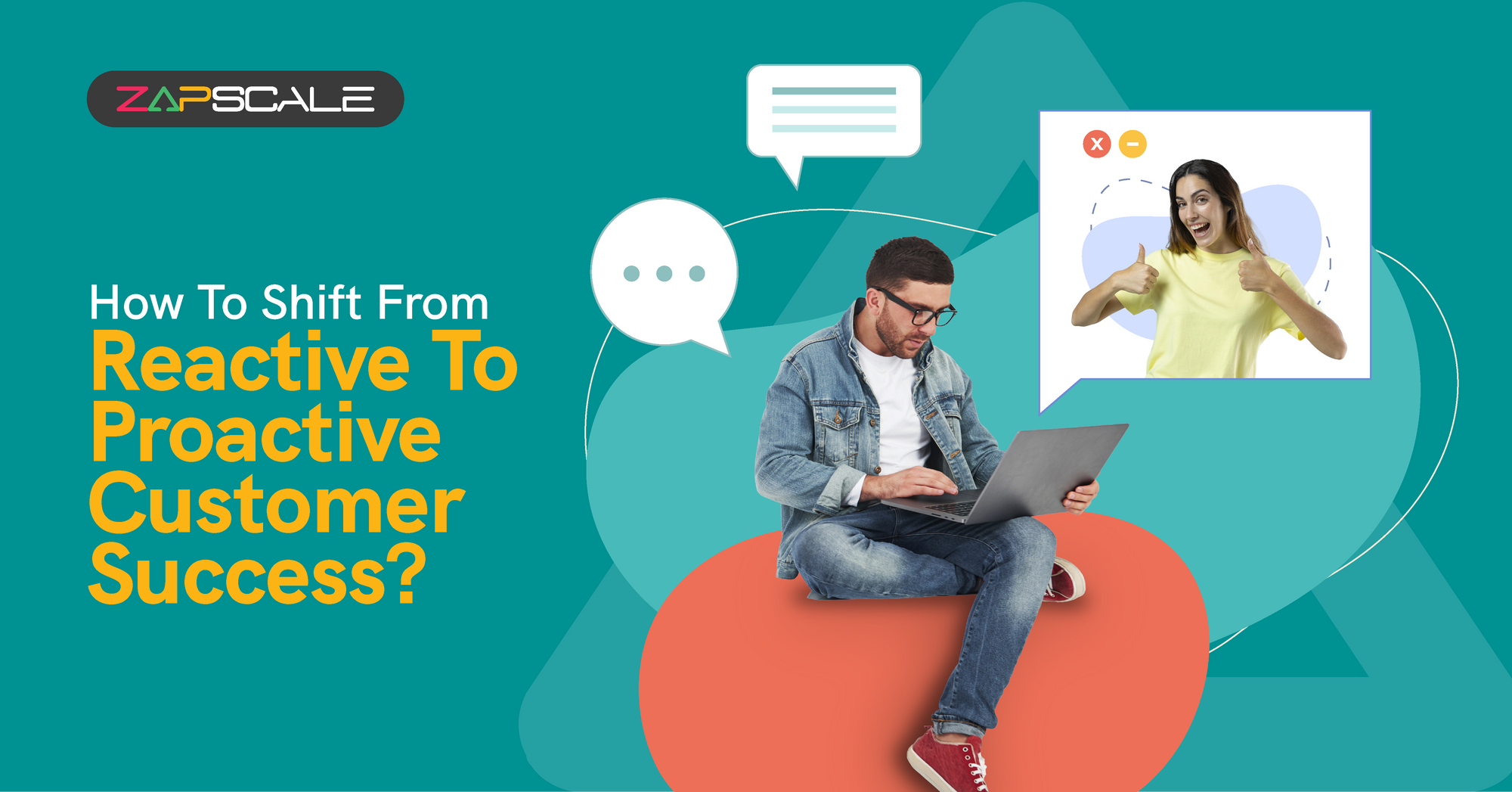CATEGORY > Customer Success Management
Your Practical Playbook for Customer Success OKRs

Just as every successful person requires a roadmap, the same way SaaS businesses rely on customer success OKRs to stay afloat.
How? Find out below.
What Are Customer Success OKRs?
Customer success OKRs (Objectives and Key Results) are metrics a business sets to assess how well its efforts achieve customer loyalty and satisfaction.
Metrics specify the intended results, like improving product adoption or customer retention.
Key Results, such as customer satisfaction ratings or retention rates, are indicators used to monitor progress toward these goals.
Establishing crystal-clear OKRs helps organizations concentrate on activities that improve customer experiences and eventually spur business expansion.
Customer success teams employ the OKRs framework for goal-setting and progress tracking.
This system aids in defining and monitoring team goals, performance evaluation of the team about predetermined benchmarks, and achievement of targeted customer outcomes, such as increased customer engagement or higher customer retention rates.
Why Should Customer Success Teams Incorporate OKRs?
To coordinate teams in the direction of accomplishing customer-centric goals, customer success OKRs (Objectives and Key Results) function as a roadmap.
Data-Oriented Decision-Making
OKRs benefit customer success teams by enabling data-driven decision-making. Teams learn about customer habits and areas of focus by establishing quantifiable targets and critical results.
This technique improves resource allocation, identifies priority customers, assesses plan efficacy, and harnesses data for success.
1. A Proactive And Ambitious Team
In the customer success team, OKRs can boost motivation and staff engagement. Employees get a sense of direction and purpose from well-defined goals and key outcomes, which improves teamwork and creates a great work atmosphere.
2. Enhanced Communication And Cross-Functional Collaboration
Aligned objectives promote understanding and synergy, resulting in improved communication and collaboration within departments such as CS, Product, and Marketing.
This partnership allows for joint initiatives such as improving goods based on customer feedback and using customer stories to target marketing campaigns. OKRs help coordinate goals across teams while driving collaborative success across departments.
3. Higher Customer Satisfaction And Retention
By setting OKRs centered on customer happiness, CS teams can actively work towards metrics like Net Promoter Score (NPS) or customer churn rate reduction.
This laser focus on customer success translates into happier and more loyal customers who are more likely to become future brand advocates.
4. More Transparency And Accountability
OKRs promote transparency and accountability within teams by establishing explicit ownership of key results that are connected with bigger goals.
Each member's accountability for specific results fosters a sense of duty and adds to overall success.
5. Ceaseless Improvement
OKRs promote a culture of continual improvement in the customer success department. The team stays nimble in meeting changing customer needs and market conditions by refining objectives and key results regularly.
This ongoing approach allows for constant evaluation and change, allowing CS teams to remain responsive and effective in a fast-changing business environment.
Customer Success OKR Examples
OKRs aka Objectives and Key Results, offer CS teams a strong framework for setting objectives, monitoring advancement, and eventually achieving satisfied, committed customers.
Here's a detailed, sequential breakdown of OKRs customized for each stage of the SaaS customer journey
Stage 1: Onboarding & User Activation
The first step is to introduce users to the main features of your product and demonstrate its worth.
Objective: Increase New Customer Engagement
Key Result 1: At least 70% of new users should finish a basic onboarding action (like setting preferences or creating an account) in less than seven days.
Key Result 2: Increase the frequency of in-app chat interactions with new users by twice a week.
SOPs:
- Create an all-inclusive onboarding checklist and customized welcome emails to help new users with account setup, setup procedures, and training.
- Assign specialized onboarding experts to handle any queries as soon as they arise
Stage 2: Product Adoption (Exploring & Utilizing Features)
Once users get comfortable with the basics, the focus must now shift to promoting said product’s adoption and exploration.
Objective: Encourage Paid Plan Adoption of Features
- Key Result 1: Boost a major paid feature's activation rate by 20-40%, for instance, enhanced reporting or advanced analytics.
- Key Result 2: Cut the onboarding period for a new advanced feature by 30%.
SOPs:
- Create user-friendly tutorials and videos that highlight the advantages of the core paid feature.
- Prepare customized onboarding processes to help users quickly understand sophisticated features.
Stage 3: Customer Satisfaction & Retention
- As users gain familiarity with the product, the focus switches to fostering customer loyalty and minimizing attrition.
Objective: Reduce Customer Churn
- Key Result 1: Improve Net Promoter Score (NPS) from +40 to +60.
- Key Result 2: Reduce customer churn rate from 10% to 5%.
SOPs:
- Conduct regular satisfaction surveys to get input and improve NPS.
- Analyze churn patterns, engage at-risk customers, and optimize features to minimize turnover.
Stage 4: Account Expansion (Upskilling & Upselling)
By showcasing the benefits of the product and its additional attributes, CS teams can persuade current users to upgrade or opt-in for add-ons.
Objective: Drive Upsell and Cross-Sell Opportunities
Key Result 1: Increase the average revenue per user (ARPU) by 10%.
Key Result 2: Identify and contact 80% of existing customers with relevant upgrade options.
SOPs:
- Offer customized upgrades and look for upsell opportunities in user data to boost ARPU by 10-20%.
- Segment customers according to their usage patterns, then send email or targeted messaging with specific upgrade offers to 80% of the audience.
Stage 5: Customer Loyalty Or Advocacy
Happy customers spread the word about your brand, which helps you grow and creates new business prospects.
Objective: Foster Customer Advocacy/Loyalty
Key Result 1: Post 15% more customer success stories on your website.
Key Result 2: Reach a minimum of 95% in quarterly surveys measuring customer satisfaction.
SOPs:
- Use standardized templates to collect more positive customer success stories through direct outreach, surveys, or email requests.
- Maintain the relevance and efficacy of the questionnaire survey by periodically updating the same.
Customer Success OKRs vs. KPIs
OKRs and KPIs are two measurement frameworks that customer success (CS) teams use to measure and track their performance effectively. Even though they both entail measuring, their objectives are different.
How? Let’s find out below.
Customer Success OKRs
- Goal-setting Structure: With OKRs, the CS team can set ambitious, strategic goals for a predetermined period, usually quarters.
- Quantifiable Progress: OKRs stand for "key results," which quantify the accomplishment of goals like raising customer satisfaction by a specific % within a particular timespan.
- Focus and Direction: They give CS efforts a defined direction and bring the team together around a shared definition of success.
Customer Success KPIs (Key Performance Indicators)
- Precise and Actionable: Unlike OKRs, KPIs are exact, actionable measurements that offer real-time insights into customer engagement, retention, and product usage.
- Frequent Monitoring: In the case of KPIs, metrics are tracked frequently (weekly, monthly) to identify areas to pinpoint areas that require development.
- Performance Evaluation: As individual metrics, KPIs gauge specific facets of customer success.
Customer Success OKRs - How ZapScale Can Lead The Way
With the help of strategic planning and quantifiable goals, ZapScale gives SaaS companies the tools they need to create customer success OKRs that guarantee maximum customer happiness and loyalty. Find out more below.
1. Outcome Tracking
ZapScale strives to ensure that customer success activities are in line with business goals by establishing specific objectives. With ZapScale, you can quickly measure its success by carefully monitoring important metrics like customer satisfaction scores and retention rates.
2. Health Analytics
On the first day of onboarding ZapScale, you can get pre-configured health scores based on 40 KPIs. ZapScale allows you to track the customer health accounts easily while paying attention to product adoption and usage trends.

3. Predictive Alerts
ZapScale uses predictive alerting systems to foresee possible problems or opportunities. This enables users to take proactive measures to drive positive outcomes and mitigate risks by using data to forecast customer behavior.
4. Account Segmentation
With ZapScale, you can categorize customers based on consumption, industry, and interaction, allowing for personalized success efforts that optimize resource allocation, improve satisfaction, and increase retention rates.
Conclusion
Customer success OKRs are the backbone of SaaS businesses. They empower teams to innovate, grow, and provide remarkable experiences in the dynamic digital environment.
With ZapScale's comprehensive insights, firms can optimize their OKR processes like never before.
FAQs
Q: What are the advantages of adopting OKRs in Customer Success?
A: OKRs are a perfect fit for improving your CS strategy because they encourage data-driven decisions, team participation, customer satisfaction, transparency, and continuous progress.
Q. How to create effective OKRs?
A: Establish two to three quantifiable key results (e.g., "Reduce churn by 5%") for each of your ambitious yet well-defined objectives (e.g., "Enhance Customer Retention"). Achieve SMART (specific, measurable, attainable, relevant, and time-bound) key results.
Q. Are OKRs meant to be fixed or constant?
A: OKRs are adaptive and flexible in response to changing objectives, market conditions, and developing business needs.
ABOUT THE AUTHOR
Sonali is a social media enthusiast and creative content writer with 3+ years of experience. With a passion for storytelling, Sonali delivers content that inspires, informs, and captivate readers.
Popular from Customer Success Management
Quality Content,
Straight To Your Inbox!
Subscribe for the latest blogs, podcasts, webinars, and events!

Write a Blog
If you have experience in CS and
a flair for writing, we’d love to
feature you.
Write to us on
hello@zapscale.com




